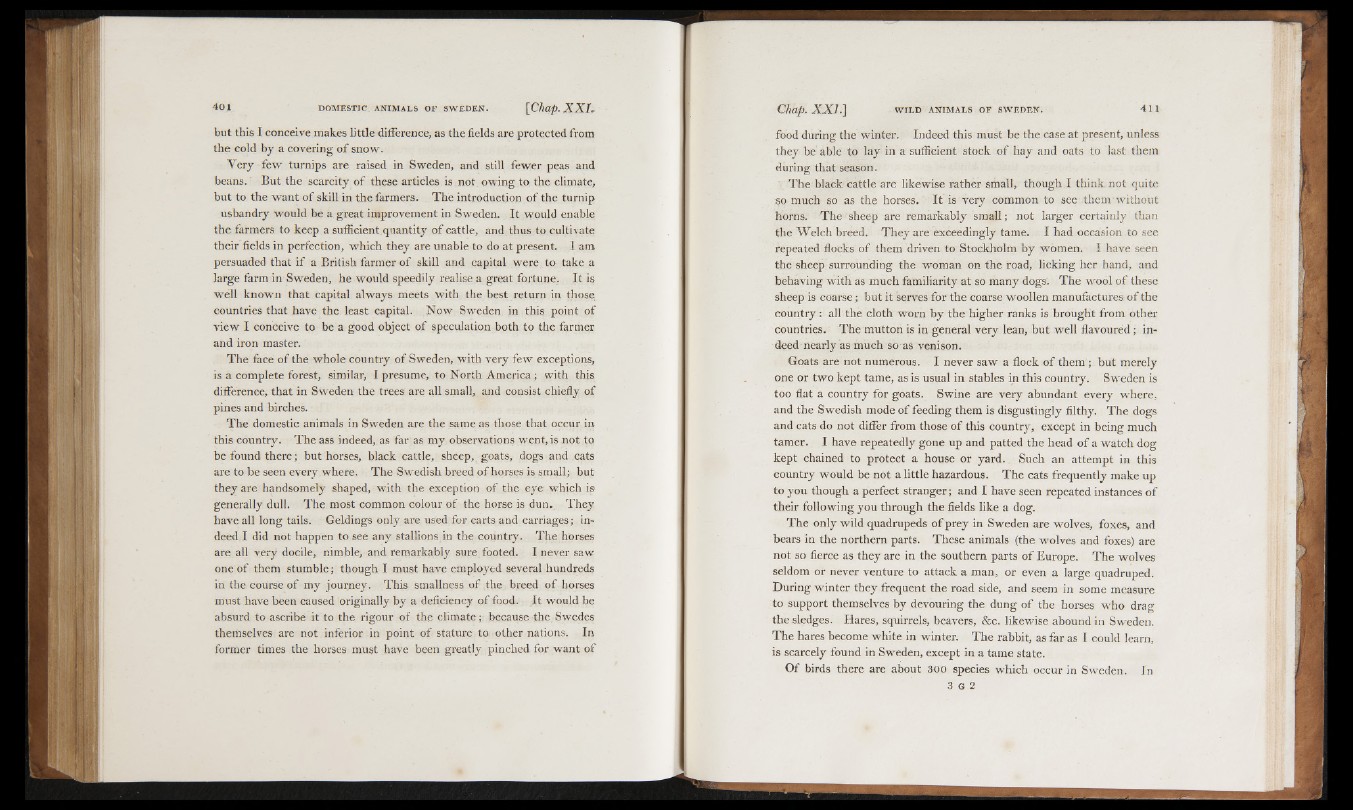
but this I conceive makes little difference, as the fields are protected from
the cold by a covering of snow.
Very few turnips are raised in Sweden, and still fewer peas and
beans. But the scarcity of these articles, is not owing to the climate,
but to the want of skill in the farmers. The introduction of the turnip
usbandry would be a great improvement in Sweden. It would enable
the farmers to keep a sufficient quantity of cattle, and thus to cultivate
their fields in perfection, which they are unable to do at present. I am
persuaded that if a British farmer of skill and capital were to take a
large farm in Sweden, he would speedily realise a great fortune. It is
well known that capital always meets with the best return in those
countries that have the least capital. Now Sweden in this point of
view I conceive to be a good object of speculation both to the farmer
and iron master.
The face of the whole country of Sweden, with very few exceptions,
is a complete forest, similar, I presume, to North America; with this
difference, that in Sweden the trees are all small, and consist chiefly of
pines and birches.
The domestic animals in Sweden are the same as those that occur in
this country. The ass indeed, as far as my observations went, is not to
be found there; but horses, black cattle, sheep,, goats, dogs and eats
are to be seen every where, The Swedish breed of horses is small; but
they are handsomely shaped, with the exception of the eye which is
generally dull. The most common colour of the horse is dun. They
have all long tails. Geldings only are used for carts and carriages ; indeed
I did not happen to see any stallions in the country. The horses
are all very docile, nimble, and remarkably sure, footed. I never saw
one o f them stumble; though I must have employed several hundreds
in the course of my journey. This smallness of the breed of horses
must have been caused originally by a deficiency of food. It would be
absurd to ascribe it to the rigour of the climate; because the Swedes
themselves are not inferior in point of stature to other nations. In
former times the horses must have been greatly pinched for want o f
food during the winter. Indeed this must be the case at present, unless
they be able to lay in a sufficient stock o f hay and oats to last them
during that season.
The black cattle are likewise rather small, though I think, not quite
so much so as the horses. It is very common to see them without
horns. The sheep are remarkably small; not larger certainly than
the Welch breed. They are exceedingly tame. I had occasion to see
repeated flocks o f them driven to Stockholm by women. I have seen
the sheep surrounding the woman on the road, licking her hand, and
behaving with as much familiarity at so many dogs. The wool o f these
sheep is coarse; but it serves for the coarse woollen manufactures of the
country : all the cloth worn by the higher ranks is brought from other
countries. The mutton is in general very lean, but well flavoured ; indeed
nearly as much so as venison.
Goats are not numerous. I never saw a flock o f them ; but merely
one or two kept tame, as is usual in stables in this country. Sweden is
too flat a country for goats. Swine are very abundant every where,
and the Swedish mode o f feeding them is disgustingly filthy. The dogs
and cats do not differ from those of this country, except in being much
tamer. I have repeatedly gone up and patted the head of a watch dog
kept chained to protect a house or yard.. Such an attempt in this
country would be not a little hazardous. The cats frequently make up
to you though a perfect stranger; and I have seen repeated instances of
their following you through the fields like a dog.
The only wild quadrupeds o f prey in Sweden are wolves, foxes, and
bears in the northern parts. These animals (the wolves and foxes) are
not so fierce as they are in the southern parts of Europe. The wolves
seldom or never venture to attack a man, or even a large quadruped.
During winter they frequent the road side, and seem in some measure
to support themselves by devouring the dung o f the horses who drag
the sledges. Hares, squirrels, beavers, &c. likewise abound in Sweden.
The hares become white in winter. The rabbit, as far as I could learn,
is scarcely found in Sweden, except in a tame state.
Of birds there are about 300 species which occur in Sweden. In
3 o 2